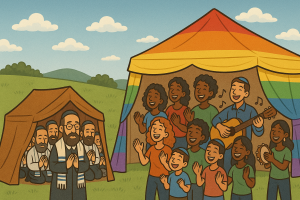Clergy can only hope the Jews in the pews appreciate the mix of planning and spontaneity required to keep services moving and congregants engaged
RABBI AVI FINEGOLD
FOUNDER, THE JEWISH LEARNING LIBRARY, MONTREAL
RABBI PHILIP SCHEIM
BETH DAVID B’NAI ISRAEL BETH AM CONGREGATION, TORONTO
Rabbi Finegold: The past couple of years have been the first in my adult life when I have not been leading services for the High Holidays and was free to be a simple mitpalel, a person at prayer. I must say this has been most enlightening for me, both as a personal Jew who gets to engage with the tfillot and also as someone who will likely go back to leading services at some point in the future.
I was curious as to your thoughts on having spent a career in the pulpit and not in a pew when it comes to the High Holiday service. Are there things that you miss or wish your congregants knew about the job? Are there things you wonder about with regard to your congregants’ experience?
Rabbi Scheim: When the time comes for me to transition from pulpit to pew, I know I will welcome the absence of stress and the luxury of no longer needing to remain constantly focused on the flow of the service.
I find the most challenging High Holiday service to be Neilah, which must end at precisely the moment when the fast concludes. The rabbi assumes the role of the official timekeeper. Will an explanation need to be added so as not to end too early? Or will a non-essential piyyut have to be skipped in order to end on time? This is more stressful than most people might imagine.
I know that it is not easy to be a congregant on the High Holidays, with huge crowds and complex, difficult liturgy. I am reassured by participants’ desire to be part of the Jewish world, and respect them for persisting in an experience not devoid of challenge.
The fact that they come back for more, year after year, is one of the joyous wonders of the Jewish world.
Rabbi Finegold: While the rabbi may have to worry about the pacing, the shaliach tzibur, the cantor, must worry about so many other pieces. I remember having to decide when a song was warranted and when it was sufficient to rely on nusach melodies, and, after carefully planning each step of the service, deciding on the spur of the moment that things were lagging and scrambling to find a song that would lift everyone. Or, being asked to cut a song when the rabbi decided we needed to move things along.
There are so many pieces to the service puzzle that must come together perfectly, and I hope that congregants appreciate what goes into it.
Sure, there are passages that are always uplifting, like the Unetaneh Tokef and the repeated refrain of HaShem HaShem on Yom Kippur. But there are also passages that must be maddening and perplexing for the average congregant, such as the section of the Mussaf on Yom Kippur that deals with the high priests’ Temple duties. I really wish there was a way to make these long recitatives more engaging for congregants.
I recall one rabbi who once instructed me to simply read a section to myself while he stood at the pulpit and gave a detailed explanation of what was being said. It certainly felt like a step in the right direction.
How do you deal with this or other parts of the service that can be prone to boredom or used as an excuse for leaving services?
Rabbi Scheim: As a rabbi who enjoys chazzanut, I receive in advance a list of the portions that are very special to the cantor and make sure not to skip those sections. We agree in advance as to the “skippable” portions, since it’s important that the congregation have the opportunity to hear some classical renditions and to sing with the cantor during familiar and even newly introduced melodies.
In terms of the lengthy and unexciting portions, often the cantor will begin the recitation, allowing the congregation to continue silently. I will offer voice-over commentary, interpretive and, hopefully, inspirational readings. In the martyrology section on Yom Kippur, for example, the traditional chant will be interspersed with Holocaust reflections and remembrances.
As long as the clergy remain engaged and enthused by the liturgical opportunities on the Yamim Nora’im, hopefully some of that energy will carry over to the pews and engage worshippers in an otherwise potentially trying and less-than-riveting experience.
Click here for last week's edition of Rabbi 2 Rabbi.






